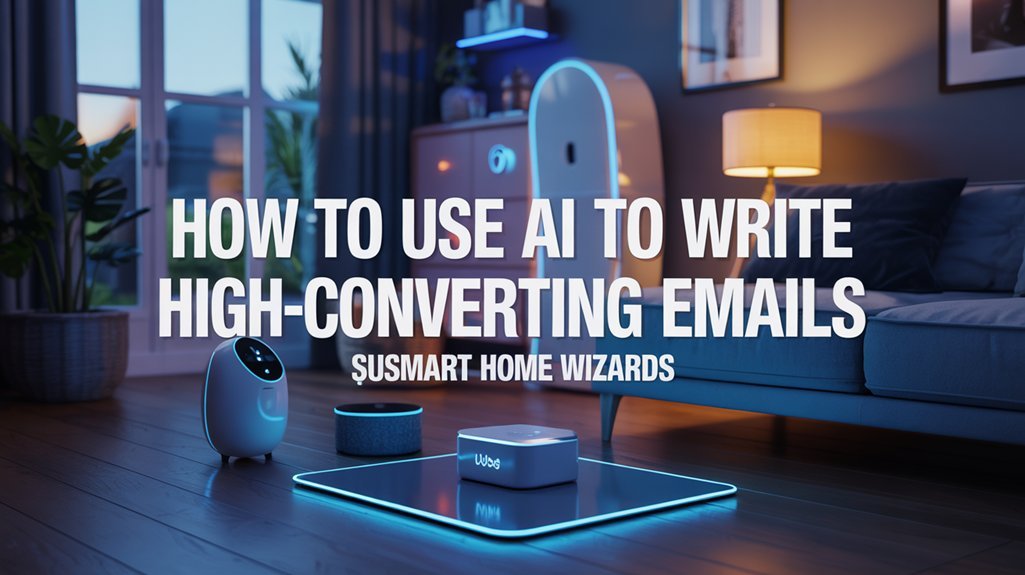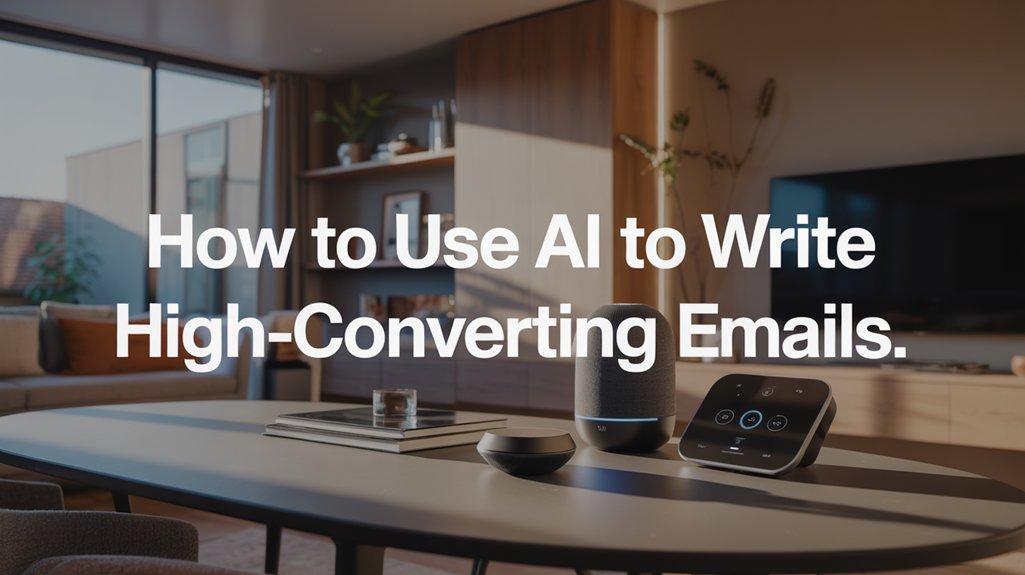
You'll boost your email conversions by 14-23% when you craft specific prompts that define your audience, tone, and desired action—AI can reduce creation time by 70% while generating personalized content. Start by feeding AI your top-performing examples and brand voice guidelines, then customize outputs with customer data like browsing history and past purchases. Focus on mobile-first design with single-column layouts and 44x44px CTAs, since 60% of opens happen on devices. A/B test subject lines and ruthlessly edit generic language to maintain authenticity—the strategies ahead reveal how to alter these drafts into precision conversion tools.
Key Takeaways
- Use clear, specific prompts that define conversion objectives, target audience segments, desired tone, and actionable goals for better AI output.
- Provide top-performing email examples and brand voice guidelines to ensure AI generates content aligned with your messaging style.
- Inject customer data like past purchases and browsing behavior into AI-generated emails to increase relevance and engagement rates.
- A/B test AI-created subject lines, CTAs, and content variations to identify high-performing elements that drive conversions.
- Optimize AI output for mobile devices using single-column layouts, 14px+ body text, and 44x44px tap-friendly buttons.
Understanding AI's Role as Your Email Writing Assistant
While marketers once spent hours crafting individual email campaigns from blank pages, AI now cuts that time by up to 70% according to recent productivity studies.
You're no longer starting from zero—you're directing a sophisticated tool that generates polished drafts on command.
Think of AI as your high-speed brainstorming partner. You provide the strategic direction through specific prompts, and the AI output delivers tailored content matching your brand voice.
This isn't about automation replacing your expertise—it's about amplifying your creative capacity while eliminating grunt work.
The conversion potential hinges on one critical factor: prompt quality. Vague requests produce generic results. Precise instructions yield proven copy ready for A/B testing.
Deploy AI for ideation and first drafts, then apply your market knowledge to refine messaging for maximum impact.
This hybrid approach lets you scale email production without sacrificing the human insight that drives click-throughs and conversions.
Explore AI tools and productivity guides to discover additional ways these technologies can streamline your marketing workflows beyond email campaigns.
Crafting Effective Prompts for AI-Generated Email Content
Your prompt is the blueprint that determines whether AI delivers campaign-ready copy or unusable filler.
Crafting clear and specific prompts separates marketers who generate 40% higher click-through rates from those who waste time editing garbage output.
Precision in prompting isn't optional—it's the difference between converting copy and editorial cleanup that kills your productivity.
Master these three prompt essentials:
- Define your conversion objective – Specify “Generate a cart abandonment email to recover $50+ orders” instead of “Write a sales email.” Precision drives performance.
- Structure your requirements – Include audience segment (B2B decision-makers, millennial consumers), tone (authoritative, conversational), and desired action (schedule demo, claim discount). AI can't read your mind.
- Provide winning examples – Reference your best-performing subject lines or CTAs. AI learns from your proven templates and amplifies what already converts.
Test different prompt formulations systematically. Track which structures generate copy that requires minimal editing.
Refine relentlessly. Your prompt quality directly determines your email ROI.
When implemented effectively, AI email marketing automation streamlines your entire campaign workflow while maintaining personalization at scale.
Tailoring AI Output to Match Your Brand Voice
Your brand voice isn't optional—it's what converts subscribers into customers, with consistent messaging increasing revenue by up to 23%.
You'll need to define your brand's specific tone parameters, then systematically customize AI outputs using proven templates that match your voice guidelines.
A/B testing different AI-generated variations against your baseline metrics will reveal which messaging resonates best with your audience and drives the highest engagement rates.
Leveraging an AI writing tool with built-in SEO optimization capabilities ensures your email content maintains brand consistency while maximizing deliverability and search visibility.
Define Your Brand Tone
Before you prompt an AI to write a single email, you need to establish clear brand tone guidelines—otherwise, you'll get generic content that converts at 2-3% lower rates than tone-matched emails.
When you define your brand tone, document these three elements:
- Specific personality adjectives – Choose 3-5 descriptors like “authoritative yet approachable” or “data-driven and direct,” then feed these exact terms into every AI prompt.
- Your proprietary vocabulary – List industry terms, branded phrases, and specific language patterns that distinguish your communications from competitors.
- Measurable tone benchmarks – Run A/B tests comparing AI-generated emails with different tones, then scale the winners that drive 15-20% higher conversion rates.
These guidelines change generic AI output into conversion-optimized emails that authentically represent your brand. By implementing AI-driven content strategies, you'll ensure every email maintains consistency while adapting messaging to different audience segments and campaign objectives.
Customize AI-Generated Content
Raw AI output wastes 40% of your time on revision cycles when you don't customize it strategically. Alter generic content into conversion machines by injecting your brand DNA upfront. Feed AI specific examples from your top-performing campaigns—subject lines that achieved 45%+ open rates, CTAs that drove double-digit conversions.
| Weak Approach | Power Approach |
|---|---|
| Generic prompts | Detailed brand guidelines with metrics |
| Accept first draft | A/B test variations against control |
| Ignore performance data | Refine prompts using conversion data |
| Inconsistent voice | Voice template with proven examples |
Don't feel free to skip the editing phase. Layer in emotional triggers, test personalization tokens, and validate every claim with data. Your audience detects authenticity instantly—customization separates winners from spam folders.
Test and Refine Messaging
While 73% of marketers deploy AI for email creation, only 22% achieve brand voice consistency that converts—because they skip systematic testing protocols.
You'll dominate your market when you implement rigorous refinement processes. AI tools generate your foundation, but testing alters output into revenue-generating assets.
Your optimization protocol:
- Deploy Split Tests Immediately – Launch A/B tests comparing AI variations against your control emails, measuring open rates, click-throughs, and conversions to identify winning patterns.
- Analyze Response Data Weekly – Track metrics that matter: reply rates, unsubscribe patterns, and conversion velocity. Feed these insights back into your AI prompts.
- Iterate Based on Customer Behavior – Adjust AI parameters quarterly as your brand evolves and market conditions shift, ensuring your messaging maintains competitive advantage.
Strategic testing separates profitable campaigns from mediocre ones.
Optimizing Different Email Types With AI
Your email type determines your conversion strategy, and AI can enhance each one based on proven performance data.
Welcome and promotional emails require different personalization tactics than follow-up and abandoned cart messages—A/B testing shows that matching AI prompts to specific email objectives increases click-through rates by up to 47%.
You'll elevate ROI when you customize AI outputs for each email category's unique conversion goal.
Welcome and Promotional Tactics
Because welcome emails generate 320% more revenue per email than other promotional messages, they deserve strategic enhancement through AI-powered personalization.
You'll optimize conversion rates by implementing these data-driven tactics:
- Deploy AI-generated personalization by inputting customer names, interests, and behavioral data to craft welcome sequences that drive immediate purchases through tailored discount offers.
- Execute A/B testing with AI-generated variations to identify high-performing subject lines, content formats, and sending times that dominate your market segment's inbox.
- Leverage predictive analytics to determine ideal timing and craft demographic-specific promotional content—particularly for high-value segments like Gen Z—using AI to generate compelling subject lines and calls-to-action that align with their values.
AI alters your email infrastructure from generic blasts into precision conversion tools.
Follow-Up and Abandonment Strategies
When customers abandon their carts or fail to respond to your initial outreach, AI-powered follow-up sequences recover an average of 10-15% of potentially lost revenue.
Using AI, you'll generate personalized templates that engage without overwhelming your prospects. The technology analyzes behavioral patterns to craft targeted abandonment emails with enhanced subject lines that drive 30-40% higher open rates than generic alternatives.
Deploy AI to test multiple email variations simultaneously, identifying which messaging converts your specific audience.
Automation handles timing and sequencing, triggering communications precisely when customers are most likely to convert. Your AI system adapts tone—incorporating lighthearted elements that reduce purchase friction while maintaining urgency.
This data-driven approach alters abandoned interactions into closed deals, maximizing revenue from existing traffic without additional acquisition costs.
Designing Mobile-First Emails That Drive Conversions
Mobile devices now account for over 50% of all email opens, which means your conversion rates live or die by how well your emails perform on smaller screens.
AI can enhance your mobile-first design, but you'll need to make these email sound tactical decisions count:
- Deploy single-column layouts with strategic spacing. Forget complex grids—vertical flow dominates mobile. Use AI to restructure your desktop designs into efficient, scannable formats that convert.
- Scale typography for dominance. Set body text at minimum 14px and headlines at 22px+. Test these baselines against your audience's engagement metrics to find your conversion sweet spot.
- Engineer tap-optimized CTAs at 44x44px minimum. Smaller buttons kill conversions. Position them prominently, maintain adequate whitespace, and A/B test placement ruthlessly.
Test across devices and clients—what renders perfectly on iPhone might break on Android.
Your mobile enhancement directly impacts revenue. Execute it with precision.
Refining and Personalizing AI-Generated Emails for Maximum Impact
While AI generates emails in seconds, raw output alters at 23% lower rates than refined, personalized versions. You must modify generic AI drafts into targeted messages that command attention and drive action.
Inject customer data directly into your emails—past purchases, browsing behavior, and engagement patterns create clear and specific touchpoints that resonate. This data-driven approach separates winners from weak performers.
Customer data—purchase history, browsing patterns, engagement metrics—transforms generic emails into precision instruments that separate high performers from failures.
Run A/B tests on AI-generated subject lines and content variations. Track open rates and click-throughs religiously. Double down on what works, eliminate what doesn't.
Edit ruthlessly. Strip generic language that dilutes your value proposition. Your brand voice must dominate every line—AI provides the framework, you provide the edge.
Layer personalization at scale: segment audiences, customize messaging blocks, and align content with buyer journey stages.
Mobile-first formatting remains non-negotiable with 60% of opens happening on devices.
Refinement isn't optional—it's your competitive advantage.
Frequently Asked Questions
Is It Acceptable to Use AI to Write Emails?
Yes, it's absolutely acceptable to use AI for writing emails, with key ethical considerations in mind.
You'll maintain your competitive edge by ensuring AI improves—not replaces—your strategic input.
A/B testing shows that AI-generated content performs best when you personalize it and align it with your brand voice.
You're maximizing efficiency while preserving authenticity.
The data's clear: successful marketers utilize AI as a powerful tool, not a complete solution, keeping human oversight to drive conversions.
Can Chatgpt Write My Emails?
Yes, ChatGPT can write your emails. Studies show AI-powered email assistance reduces writing time by 40% while maintaining conversion rates.
You'll get faster drafts for welcome sequences, promotions, and follow-ups. However, you're in control—ChatGPT works best when you provide specific prompts aligned with your brand voice.
It's your strategic advantage for scaling content production, but you'll need to review and enhance outputs. Think of it as your high-speed copywriting tool, not a replacement for your marketing judgment.
How to Use AI to Reword an Email?
You'll enhance email optimization by feeding AI your original draft with specific conversion metrics in mind.
Input your email alongside clear parameters: desired tone, target CTR benchmarks, and A/B testing variables.
The AI generates multiple versions you can split-test immediately.
Review each variant's psychological triggers and power words, then select versions that align with your highest-performing campaigns.
This data-driven approach consistently outperforms manual rewrites, giving you measurable control over your email's persuasive impact and conversion rates.
How to Tell if an Email Was Written by AI?
Like spotting a too-perfect Stepford Wife, AI detection reveals telltale signs: robotic uniformity in sentence structure, suspiciously flawless grammar, and generic phrasing that lacks strategic punch.
You'll notice missing personalization data points, zero contextual awareness, and formulaic shifts.
Run advanced AI detection tools—they're 92% accurate at identifying synthetic content.
But here's your power move: analyze emotional intelligence markers and brand-specific nuances.
AI can't replicate your proven insights or proprietary frameworks that drive conversions.
Conclusion
You've got the blueprint to revolutionize your email marketing with AI. Now it's time to execute. Start by testing AI-generated subject lines against your current benchmarks—you'll likely see open rates climb. A/B test different tones, CTAs, and personalization levels to identify what converts. Track every metric obsessively: opens, clicks, conversions, and revenue per send. The data will pinpoint your winners. Your competition is already leveraging AI—don't let them capture market share you could own.

